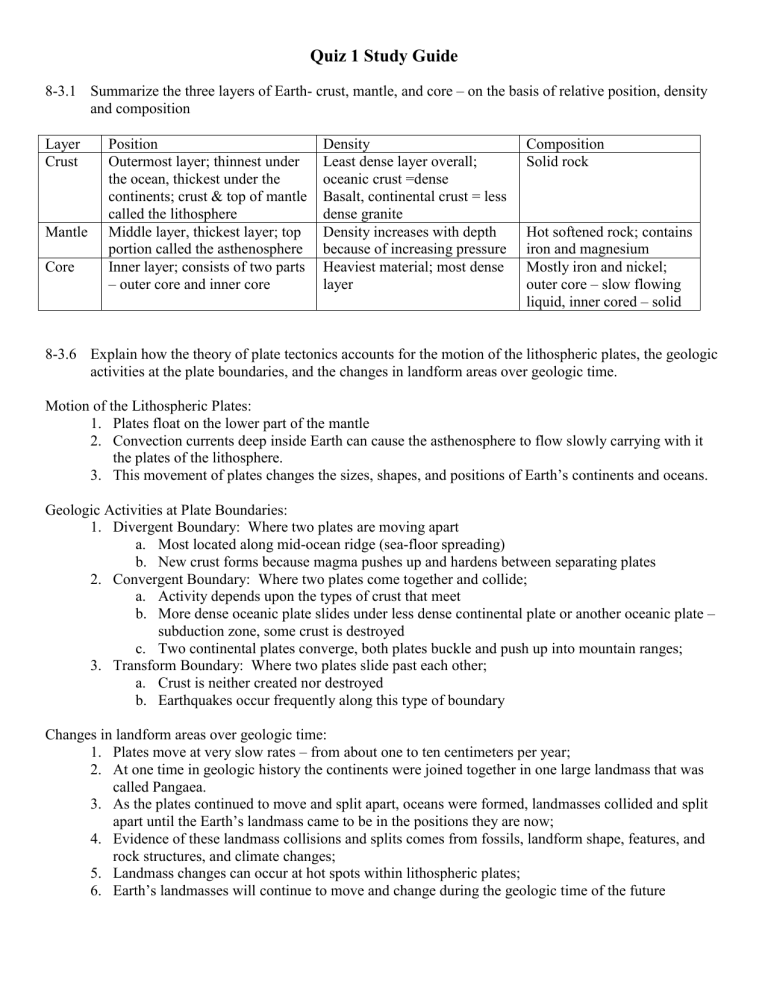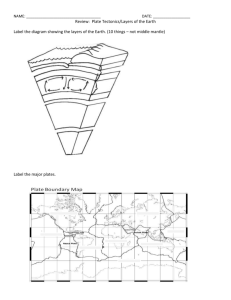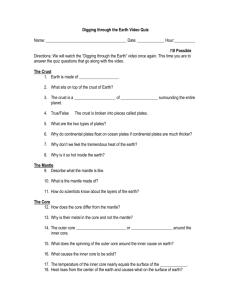Earth`s Structure quiz 1 study guide

Quiz 1 Study Guide
8-3.1
Summarize the three layers of Earth- crust, mantle, and core – on the basis of relative position, density and composition
Layer Position
Crust Outermost layer; thinnest under the ocean, thickest under the continents; crust & top of mantle called the lithosphere
Mantle
Core
Middle layer, thickest layer; top portion called the asthenosphere
Inner layer; consists of two parts
– outer core and inner core
Density
Least dense layer overall; oceanic crust =dense
Basalt, continental crust = less dense granite
Density increases with depth because of increasing pressure
Heaviest material; most dense layer
Composition
Solid rock
Hot softened rock; contains iron and magnesium
Mostly iron and nickel; outer core – slow flowing liquid, inner cored – solid
8-3.6
Explain how the theory of plate tectonics accounts for the motion of the lithospheric plates, the geologic activities at the plate boundaries, and the changes in landform areas over geologic time.
Motion of the Lithospheric Plates:
1.
Plates float on the lower part of the mantle
2.
Convection currents deep inside Earth can cause the asthenosphere to flow slowly carrying with it the plates of the lithosphere.
3.
This movement of plates changes the sizes, shapes, and positions of Earth’s continents and oceans.
Geologic Activities at Plate Boundaries:
1.
Divergent Boundary: Where two plates are moving apart a.
Most located along mid-ocean ridge (sea-floor spreading) b.
New crust forms because magma pushes up and hardens between separating plates
2.
Convergent Boundary: Where two plates come together and collide; a.
Activity depends upon the types of crust that meet b.
More dense oceanic plate slides under less dense continental plate or another oceanic plate – subduction zone, some crust is destroyed c.
Two continental plates converge, both plates buckle and push up into mountain ranges;
3.
Transform Boundary: Where two plates slide past each other; a.
Crust is neither created nor destroyed b.
Earthquakes occur frequently along this type of boundary
Changes in landform areas over geologic time:
1.
Plates move at very slow rates – from about one to ten centimeters per year;
2.
At one time in geologic history the continents were joined together in one large landmass that was called Pangaea.
3.
As the plates continued to move and split apart, oceans were formed, landmasses collided and split apart until the Earth’s landmass came to be in the positions they are now;
4.
Evidence of these landmass collisions and splits comes from fossils, landform shape, features, and rock structures, and climate changes;
5.
Landmass changes can occur at hot spots within lithospheric plates;
6.
Earth’s landmasses will continue to move and change during the geologic time of the future








